Why AI translation software is here to stay and how it can benefit you
Artificial intelligence (AI) is more popular than ever in business. Companies in every industry now use it to deliver higher-quality outcomes in less time—the translation industry included.
Let’s walk through what AI translation is and how it can maximize translation ROI for your brand.
AI translation defined
What comes to mind when you hear the term “AI translation”? If machine translation (MT) does, you’re on the right track.
AI translation also encompasses large language models (LLMs) and various other machine learning, deep learning, and natural language processing (NLP) techniques.
As a result, AI has applications across the entire translation workflow, both before and after the translation stage.
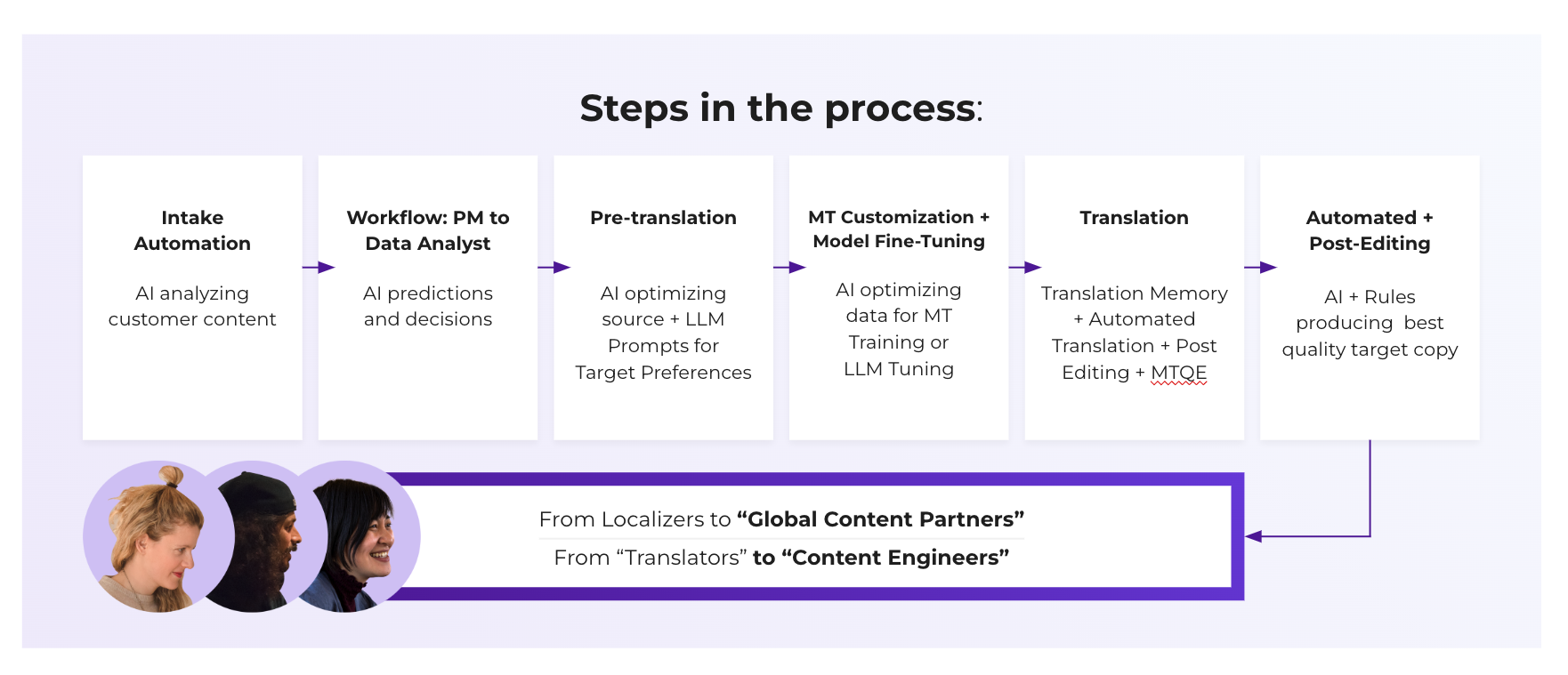
How can AI help with localization?
Here are a few use cases for AI in the localization process.
Pre- or post-editing of text
LLMs are trained on datasets that contain billions of parameters. Using NLP, they’re able to identify linguistic patterns and semantic relationships. This enables them to understand and replicate human language, which comes in handy for pre- and post-editing.
For example, Smartling’s GPT-enabled portal, Smartling Translate, takes your brand’s voice, style, and terminology into account to produce high-quality, accurate machine translations instantly. In our GPT and Large Language Models webinar, we showed how you can use Smartling Translate to:
- Correct spelling, grammar, punctuation, and capitalization errors
- Adjust formality
- Rephrase text
Using GPT to pre-edit content in the source language ultimately means higher-quality translated text output. But you can also use large language models to “smooth” completed translations, improving their accuracy and fluency.
Content translation
Neural machine translation (NMT) is currently the most prevalent form of MT, and we also see a lot of promise in the use of LLMs to aid in the translation process. Both use neural networks that mimic the way the human brain works.
Rather than swap out individual words based on pre-set rules, NMT engines consider context to translate words correctly. They learn over time, which allows them to translate more accurately. Overall, they’re better than their predecessors—statistical MT models—at capturing the intended meaning of source text.
An example of machine translation in action is Smartling’s Neural Machine Translation (NMT) Hub, which is a cloud-based MT model driven by AI. The NMT Hub uses AI to select the best MT engine for your content, which results in the highest quality MTs in a private and secure environment.
Workflow automation
AI can reduce both your manual workload and your publishing time by automating various project management tasks, such as:
- Assigning jobs
- Reviewing and revising content
- Submitting content
- Rejecting content
Smartling’s Dynamic Workflows use AI to route content to the right step in the process based on conditions you set. As a result, Smartling customers have been able to automate 90% or more of their efforts.
Should artificial intelligence translation replace your human translators?
As you can see, AI has extensive capabilities as it relates to translation workflows and efficiencies.
However, that doesn’t mean you should stop working with professional translators altogether.
In episode one of our LanguageAI Reality Series episode, Andrew Batwash, our Associate Director of Language Services commented on the following:
You can design AI systems to have effective and meaningful human intervention. What we want to do as a service provider in the language services space is really think about where the human comes into the human-in-the-loop system. How do they add value? And is it in the right place at the right time to generate the output that the customer is looking for?”
“A lot of the conversation is like, we're taking work away from translators and we're going into this fully automatic world. That's not really what it is. It's going to be something more in the middle. Those systems, in a lot of ways, are going to help people be more productive.”
In part, that productivity advantage stems from progressive advancements in the functionality and reliability of AI tools used for translation work.
How reliable is AI translation?
The higher the quality of training data (and user input), the more reliable AI is.
The opposite is also true. This is why custom MT engines are so valuable: They’re trained on language specific to your company and domain via your translation memory and glossaries. As a result, they can output accurate, on-brand translations.
In contrast, it’s also why some large language models struggle with content translation. Many have limited training data in non-English target languages, making it more challenging to generate highly accurate, culturally-relevant translations.
The situation is similar to the AI used for process automation, which learns from patterns in training data. Whatever patterns you set, the AI will continue—for better or worse.
Of course, your input matters, too.
Give an LLM a poorly engineered prompt, and it will be harder to get good translation results. Give an MT engine a low-quality piece of content, and the translated version will likely have some of the same quality issues.
How AI translation software has developed in recent years
AI, in general, is a quickly developing and rapidly changing technology that has had a huge impact on the quality of translation software in recent years.
Important improvements and developments include:
- The introduction of the Transformer architecture in 2017, which improved models’ ability to understand context and made possible the likes of Google’s BERT and OpenAI’s GPT
- The widespread use of pre-trained language models like GPT-3 and GPT-4
- The use of attention mechanisms, a part of the Transformer architecture, which have allowed models to focus on specific components of an input sequence when generating an output sequence and have improved how models handle long sentences
- The introduction of multilingual models, which allowed a single model to handle multiple languages and made for faster, more resource-friendly translation software
How an AI translator differs from a human translator
Why leverage artificial intelligence rather than sticking to the traditional human-driven translation process?
Speed
On any given day, your to-do list could include most or all of the following:
- Sourcing vendors and vetting their translation services
- Communicating with stakeholders, linguists and translation vendors, subject matter experts, and others
- Prepping content for translation
- Creating translation tasks and assigning the appropriate individuals at various stages of the process
- Keeping tabs on the status of various translation jobs
- Overseeing quality assurance (QA) and addressing issues that come up
- Reviewing translation reports and identifying bottlenecks or optimization opportunities
All of this can take a good amount of time when done manually, and you probably have other responsibilities too! Incorporating more AI into your processes is the key to freeing your time to focus on the highest-impact activities.
Cost
MT costs a fraction of the price of human translation.
The latter typically costs $0.15 to $0.30 per word, but MT often costs as little as $0.000010 per character. This means cost savings of tens or even hundreds of thousands of dollars per year.
You can then reinvest that money into high-priority language translation projects or use it to support other business initiatives.
Scalability
The time and cost savings associated with AI translation solutions also mean that these solutions are more scalable. You can expand into new markets and translate more of your content faster. And you can reinvest the money you save into larger localization efforts.
Quality
You might think professional translators have the ultimate advantage because they can capture emotion, consider context, and apply local and cultural expertise to translations.
But incorporating AI into your processes can contribute to quality as well.
Automated quality checks can bring your attention to issues that need fixing. Quality estimation algorithms can alert you to translations that need review or revision, and help you quickly identify content that’s ready for publishing.
How to pick the right AI translation solution
Of course, you’ll want a solution that strikes a good balance between quality, cost, and speed. But also consider the following:
- Supported languages: Some tools support fewer languages and language pairs than others. Think not just about your current translation needs but also about language pairs you may need in the near future.
- Training data: Some MT engines, for example, come trained on certain domains out of the box. Others allow custom model training. Either way, industry-specific training data will improve translation quality.
- Integrations and application programming interfaces (APIs): For more efficient workflows, use AI translation solutions that integrate with other tools you use, such as your content management system, or work with APIs.
- Security: Especially if you’ll be translating sensitive, confidential texts like legal documents, it’s imperative that you have enterprise-grade security to protect your data.
Even with these criteria in mind, though, it can still be hard to pick because of the ever-increasing number of AI-powered tools out there.
The top 6 AI translation services and tools
Now that you have a better understanding of what AI translation is and its benefits, here are some AI-powered tools and services to look into.
Smartling
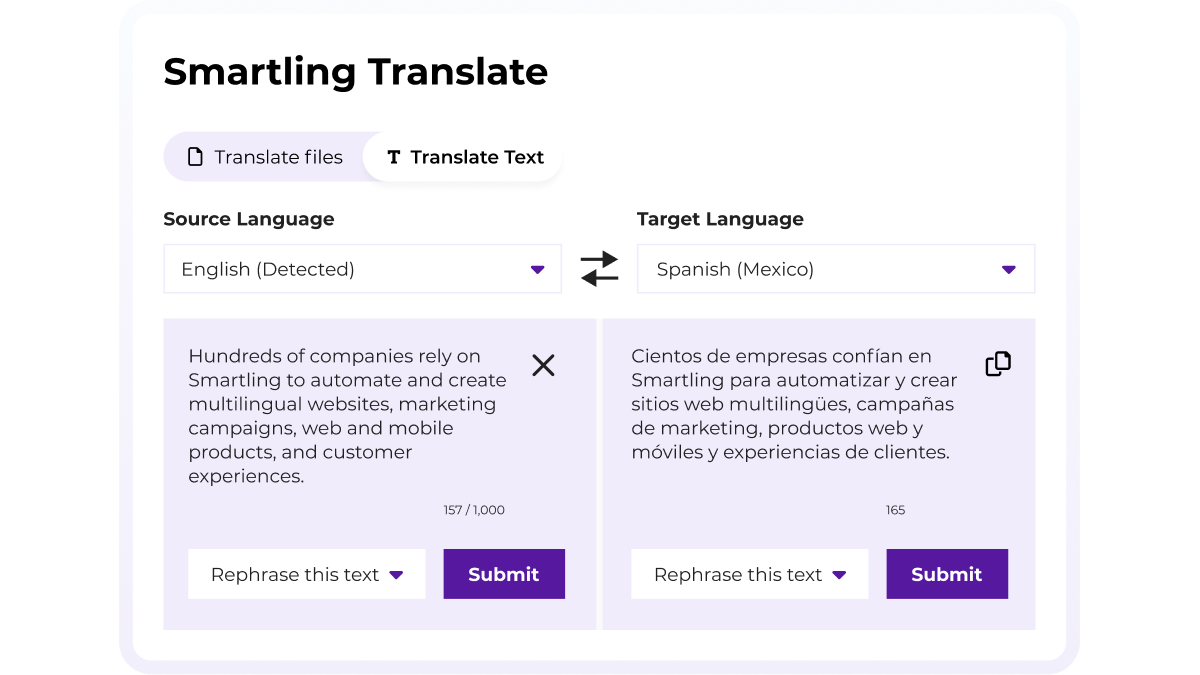
Smartling has one of the most advanced translation management systems (TMSs) in the localization industry, enabling you to leverage AI across the entire localization process.
It’s also one of the most highly rated by customers—it was rated as the #1 pick for enterprise translation management on G2 for 20 quarters in a row.
Top features:
- NMT: Manage your MT needs at scale via this multi-engine, AI-powered workspace that is capable of instantly producing high-quality, consistent, and on-brand translations.
- Translation management platform: Access a content repository and administrative suite for all of your localized content.
- Smartling Translate: Translate text and files securely in this self-service translation portal, which leverages GPT to improve translation quality and fluency.
- Connectors and integrations: Connect Smartling with dozens of other apps and tools, including content management systems, automation tools, and more to streamline your translation workflows.
- Translation proxy: Use the Global Delivery Network to deploy web experiences in any language.
- Professional translation services: Get to market faster with accurate, cost-effective translations.
Pros:
- You can produce translations of up to 350% higher quality with the NMT Hub (thanks to our multi-machine translation engine approach).
- With the help of AI, you can automate 90% or more of your translation workflows.
- We take security seriously and provide a totally private and secure translation environment.
- You can publish content 52% faster with our professional translation services.
- We offer support for dozens of common file types.
Cons:
- Some customers may take time to familiarize themselves with all of Smartling’s capabilities, but our customer success team is always happy to answer questions and give guidance to reduce the learning curve.
DeepL
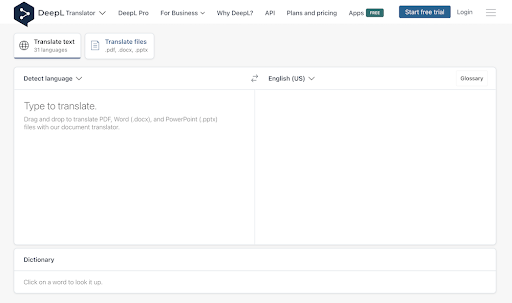
DeepL is among the most reliable neural MT engines in terms of consistent translation quality. It has several advanced features that make maintaining high quality standards easier such as the ability to choose from lists of alternative words and view definitions of words in the source and target language.
Top features:
- Unlimited text translation: Translate as much text as you need to on any paid plan.
- Tones: Choose between formal and informal tones to ensure that translated text is appropriate for your audience.
- Computer-assisted translation (CAT) tool integration: Get DeepL’s high-quality translations in the translation results of other tools, such as Smartling.
Pros:
- In addition to being one of the most reliable neural machine translation engines, DeepL is also cost-effective, meaning you can get a higher translation ROI.
- The Advanced and Ultimate plans allow you to create up to 2,000 glossaries with 5,000 entries each for greater accuracy.
- Besides the web-based version, DeepL also has desktop and mobile apps.
Cons:
- DeepL supports fewer languages and, therefore, offers fewer language pairs than some alternatives.
- Glossary support is only available for seven language pairs, although DeepL supports just under 30 languages.
Google Cloud Translation API
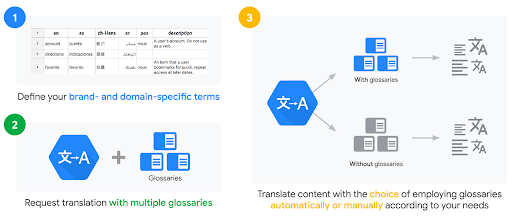
Google Cloud Translation API is the enterprise-friendly sibling of Google Translate and has two editions.
The Basic edition is mainly for short-form and user-generated content like social media content or chats. The Advanced edition is better suited for translating long-form content and performing various types of customization.
Top features:
- Batch translation: Translate numerous source documents at once to save time.
- AutoML technology: Train custom models to produce translations that use the right tone and terminology for your company and industry.
- Model selection: Choose between Google’s standard neural translation model or a custom model, depending on the content and its context.
Pros:
- Both editions include unlimited translation, which makes them good for high-volume projects.
- You can translate content into over 100 languages, and thousands of language pairs are available.
- This API makes programmatic text translation possible for your websites and applications.
Cons:
- Glossary support is only available via the Advanced edition, giving users of the Basic edition less control over terminology.
- Some users feel this machine translation solution can be expensive if you have large amounts of text to translate.
Copy.ai

Copy.ai is a broad-reaching solution that focuses on helping sales and marketing teams use generative AI for tasks like creating blog posts and writing emails.
Creating multilingual content using an AI translation solution is one of the many features that Copy.ai offers.
Top features:
- Automated workflows: Use workflow templates or create your own custom automated workflows for content creation and translation.
- Alt text generation: Create alt text for images to increase accessibility.
Pros:
- Copy.ai helps with more than just translation. You can draft a full piece of content and then translate it into multiple languages, for example.
- Copy.ai offers over 2,000 integrations with other software solutions.
Cons:
- Since Copy.ai is a broad marketing and sales tool, it doesn’t specifically focus on translation. In a rapidly advancing field, it’s more likely to be a laggard than a leader when it comes to translation developments.
Microsoft Bing Translator
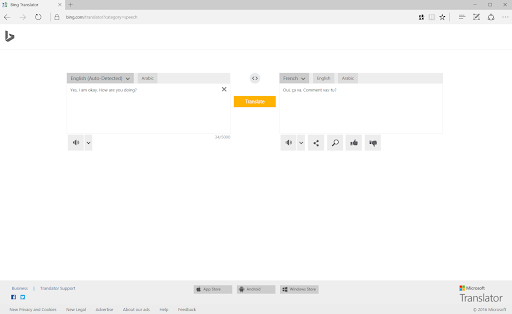
Microsoft Bing Translator is Microsoft’s version of Google Translate, one of the most widely used translation apps.
The biggest benefit here is that Bing Translator is free for both in-browser and mobile app use.
Top features:
- Regularly used phrases and prompts: These phrases are based on your interactions with the tool, as well as other users’, and help to speed up translation.
- API: An API is available for developers who want to use Bing Translator in their own software tools.
Pros:
- The business version has support for multiple document types.
- A free option is available.
- Bing Translator offers support for multiple languages.
Cons:
- No offline version is available.
- Bing Translator doesn’t offer managed translation services.
Wordly
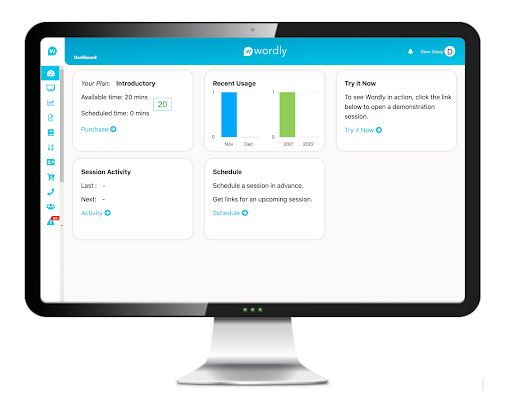
Top features:
- Two-way translation: Worldly offers live two-way translation of text or audio conversation.
- Live sign language translation: Worldly is one of the very few apps that offers sign language translation.
Pros:
- Wordly can translate videos and add captions.
- It is one of the few tools that can translate sign language.
- Wordly easily integrates with webinar platforms like Zoom and ON24.
Cons:
- It could offer more languages.
- The tool lacks a robust content management system for translated content.
Smartling: AI translation software for meaningful customer experiences
Which of these options should you go with? Luckily, if you integrate top MT engines with Smartling, you don’t have to choose. You’ll receive these engines’ quality translation results while enjoying additional benefits from the industry’s most powerful TMS.
These benefits include MT customization that uses your glossaries and translation memory to apply your brand terminology, style, and preferences, as well as AI features that improve efficiency, reduce cost, and help with quality assurance at each stage of your workflow.
Smartling is the leader in a world where AI-led translation is the solution to millions of businesses’ product and marketing needs.
Get accurate translations in seconds with zero complex configurations. Watch our short, 5-minute demo to learn more.








